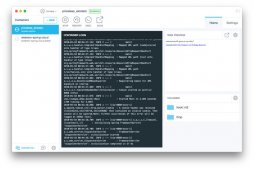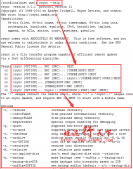1.1 第一個(gè)里程碑:安裝sersync軟件
1.1.1 將軟件上傳到服務(wù)器當(dāng)中并解壓
1、上傳軟件到服務(wù)器上 rz -E
為了便于管理上傳位置統(tǒng)一設(shè)置為 /server/tools 中
2、解壓軟件包
|
1
2
3
4
5
6
7
8
|
[root@backup sersync_installdir_64bit]# tree.└── sersync ├── bin │ └── sersync ├── conf │ └── confxml.xml └── logs |
1.1.2 二進(jìn)制包安裝方法
二進(jìn)制包安裝軟件方法(綠色軟件安裝方法):
直接解壓就可以使用
|
1
2
3
4
5
6
7
8
9
|
[root@nfs01 sersync_installdir_64bit]# mv sersync/ /usr/local/[root@nfs01 tools]# tree /usr/local/sersync/ /usr/local/sersync/ ├── bin │ └── sersync ├── conf │ └── confxml.xml └── logsdirectories, 2 files |
1.2 第二個(gè)里程碑:編寫sersync配置文件
1.2.1 常見的語法格式
rsync 配置文件編寫:ini語法
sersync配置文件編寫:xml語法
ansible配置文件編寫:yml 語法
1.2.2 修改配置文件
編寫前備份
|
1
2
3
4
|
[root@backup conf]# lltotal 4-rw-r--r-- 1 root root 2214 Oct 26 2011 confxml.xml[root@backup conf]# cp confxml.xml{,.bak} |
6-11行表示排除同步的數(shù)據(jù),等價(jià)于 --exclude 功能,表示排除
|
1
2
3
4
5
6
|
<filter start="false"> <exclude expression="(.*)\.svn"></exclude> <exclude expression="(.*)\.gz"></exclude> <exclude expression="^info/*"></exclude> <exclude expression="^static/*"></exclude></filter> |
12-21行是利用inotify的功能監(jiān)控指定的事件,等價(jià)與 -e create,delete…… 表示指定監(jiān)控事件信息
|
1
2
3
4
5
6
7
8
9
10
|
<inotify> <delete start="true"/> <createFolder start="true"/> <createFile start="false"/> <closeWrite start="true"/> <moveFrom start="true"/> <moveTo start="true"/> <attrib start="false"/> <modify start="false"/> </inotify> |
24-28行:推送到哪里 name=模塊 是rsync服務(wù)器的地址
|
1
2
3
4
5
|
<localpath watch="/data"> #監(jiān)控那個(gè)目錄<remote ip="172.16.1.41" name="backup"/><!--<remote ip="192.168.8.39" name="tongbu"/>--><!--<remote ip="192.168.8.40" name="tongbu"/>--></localpath> |
29-35行 定義rsync推送時(shí)的參數(shù)信息。
注意:不要有單詞拼寫錯誤 (true),否則程序不能正常啟動,卡死
|
1
2
3
4
5
6
7
|
<rsync> <commonParams params="-az"/> <auth start="true" users="rsync_backup" passwordfile="/etc/rsync.password"/> <userDefinedPort start="false" port="874"/><!-- port=874 --> <timeout start="false" time="100"/><!-- timeout=100 --> <ssh start="false"/></rsync> |
配置文件最終內(nèi)容:
|
1
2
3
4
5
6
7
8
9
10
11
12
13
14
15
16
17
18
19
20
21
22
23
24
25
26
27
28
29
30
31
32
33
34
35
36
37
38
39
40
41
42
43
44
45
46
47
48
49
50
51
52
53
54
55
56
57
58
59
60
61
62
63
64
65
66
67
|
[root@nfs01 tools]# cat /usr/local/sersync/conf/confxml.xml <?xml version="1.0" encoding="ISO-8859-1"?> <head version="2.5"> <host hostip="localhost" port="8008"></host> <debug start="false"/> <fileSystem xfs="false"/> <filter start="false"> <exclude expression="(.*)\.svn"></exclude> <exclude expression="(.*)\.gz"></exclude> <exclude expression="^info/*"></exclude> <exclude expression="^static/*"></exclude> </filter> <inotify> <delete start="true"/> <createFolder start="true"/> <createFile start="false"/> <closeWrite start="true"/> <moveFrom start="true"/> <moveTo start="true"/> <attrib start="false"/> <modify start="false"/> </inotify> <sersync> <localpath watch="/data"> <remote ip="172.16.1.41" name="nfsbackup"/> <!--<remote ip="192.168.8.39" name="tongbu"/>--> <!--<remote ip="192.168.8.40" name="tongbu"/>--> </localpath> <rsync> <commonParams params="-az"/> <auth start="true" users="rsync_backup" passwordfile="/etc/rsync.password"/> <userDefinedPort start="false" port="874"/><!-- port=874 --> <timeout start="false" time="100"/><!-- timeout=100 --> <ssh start="false"/> </rsync> <failLog path="/tmp/rsync_fail_log.sh" timeToExecute="60"/><!--default every 60mins execute once--> <crontab start="false" schedule="600"><!--600mins--> <crontabfilter start="false"> <exclude expression="*.php"></exclude> <exclude expression="info/*"></exclude> </crontabfilter> </crontab> <plugin start="false" name="command"/> </sersync> <plugin name="command"> <param prefix="/bin/sh" suffix="" ignoreError="true"/> <!--prefix /opt/tongbu/mmm.sh suffix--> <filter start="false"> <include expression="(.*)\.php"/> <include expression="(.*)\.sh"/> </filter> </plugin> <plugin name="socket"> <localpath watch="/opt/tongbu"> <deshost ip="192.168.138.20" port="8009"/> </localpath> </plugin> <plugin name="refreshCDN"> <localpath watch="/data0/htdocs/cms.xoyo.com/site/"> <cdninfo domainname="ccms.chinacache.com" port="80" username="xxxx" passwd="xxxx"/> <sendurl base="http://pic.xoyo.com/cms"/> <regexurl regex="false" match="cms.xoyo.com/site([/a-zA-Z0-9]*).xoyo.com/images"/> </localpath> </plugin></head> |
1.3 第三里程碑: 啟動sersync
1.3.1 修改文件的權(quán)限(可執(zhí)行)
首先讓程序讓文件有執(zhí)行權(quán)限
|
1
2
3
4
|
[root@nfs01 bin]# chmod a+x sersync [root@nfs01 bin]# lltotal 1768-rwxr-xr-x 1 root root 1810128 Oct 26 2011 sersync |
1.3.2 查看軟件的幫助信息
|
1
2
3
4
5
6
7
8
9
10
11
12
13
14
15
|
[root@nfs01 bin]# ./sersync -hset the system paramexecute:echo 50000000 > /proc/sys/fs/inotify/max_user_watchesexecute:echo 327679 > /proc/sys/fs/inotify/max_queued_eventsparse the command param_______________________________________________________重要參數(shù)-d:啟用守護(hù)進(jìn)程模式重要參數(shù)-r:在監(jiān)控前,將監(jiān)控目錄與遠(yuǎn)程主機(jī)用rsync命令推送一遍 參數(shù)-n: 指定開啟守護(hù)線程的數(shù)量,默認(rèn)為10個(gè)重要參數(shù)-o:指定配置文件,默認(rèn)使用confxml.xml文件 參數(shù)-m:單獨(dú)啟用其他模塊,使用 -m refreshCDN 開啟刷新CDN模塊 參數(shù)-m:單獨(dú)啟用其他模塊,使用 -m socket 開啟socket模塊 參數(shù)-m:單獨(dú)啟用其他模塊,使用 -m http 開啟http模塊不加-m參數(shù),則默認(rèn)執(zhí)行同步程序________________________________________________________________ |
1.3.3 在程序的bin目錄下啟動程序
|
1
|
./sersync -dro /usr/local/sersync/conf/confxml.xml |
1.3.4 啟動方法二
將/usr/local/sersync/bin/程序的bin目錄添加到PATH中
|
1
|
export PATH=/usr/local/sbin:/usr/local/bin:/sbin:/bin:/usr/sbin:/usr/bin:/root/bin:/usr/local/sersync/bin/ |
然后sersync命令就能直接使用
|
1
2
3
4
5
6
7
8
9
10
11
12
13
14
15
16
17
18
19
20
21
22
23
24
25
26
|
[root@nfs01 scripts]# sersync -dro /usr/local/sersync/conf/confxml.xml set the system paramexecute:echo 50000000 > /proc/sys/fs/inotify/max_user_watchesexecute:echo 327679 > /proc/sys/fs/inotify/max_queued_eventsparse the command paramoption: -d run as a daemonoption: -r rsync all the local files to the remote servers before the sersync workoption: -o config xml name: /usr/local/sersync/conf/confxml.xmldaemon thread num: 10parse xml config filehost ip : localhost host port: 8008daemon start,sersync run behind the console use rsync password-file :user is rsync_backuppasswordfile is /etc/rsync.passwordconfig xml parse successplease set /etc/rsyncd.conf max connections=0 Manuallysersync working thread 12 = 1(primary thread) + 1(fail retry thread) + 10(daemon sub threads) Max threads numbers is: 22 = 12(Thread pool nums) + 10(Sub threads)please according your cpu ,use -n param to adjust the cpu rate------------------------------------------rsync the directory recursivly to the remote servers onceworking please wait...execute command: cd /data && rsync -az -R --delete ./ [email protected]::nfsbackup --password-file=/etc/rsync.password >/dev/null 2>&1 run the sersync: watch path is: /data |
1.4 Inotify與 sersync總結(jié)對比
1.4.1 Inotify實(shí)時(shí)并發(fā):
結(jié)論:經(jīng)過測試,每秒200文件并發(fā),數(shù)據(jù)同步幾乎無延遲(小于1秒)
1.4.2 inotify 優(yōu)點(diǎn):
1)監(jiān)控文件系統(tǒng)事件變化,通過同步工具實(shí)現(xiàn)實(shí)時(shí)數(shù)據(jù)同步。
1.4.3 inotify 缺點(diǎn)
1)并發(fā)如果大于200個(gè)文件(10-100k),同步就會有延遲
2)我們前面寫的腳本,每次都是全部推送一次,但確實(shí)是增量的。也可以只同步變化的文件,不變化的不理。
3)監(jiān)控到事件后,調(diào)用rsync同步是單進(jìn)程的,而sersync為多進(jìn)程同步。既然有了inotify-tools,為什么還要開發(fā)sersync?
1.4.4 serysync功能多:(inotify+rsync命令)
1)支持通過配置文件管理
2)真正的守護(hù)進(jìn)程socket
3)可以對失敗文件定時(shí)重傳(定時(shí)任務(wù)功能)
4)第三方的HTTP接口(例如:更新cdn緩存)
5)默認(rèn)多進(jìn)程rsync同步
1.4.5 高并發(fā)數(shù)據(jù)實(shí)時(shí)同步方案小結(jié):
1)inotify(sersync)+ rsync,是文件級別的。
2)drbd文件系統(tǒng)級別,文件系統(tǒng)級別,基于block塊同步,缺點(diǎn):備節(jié)點(diǎn)數(shù)據(jù)不可用
3)第三方軟件的同步功能:mysql同步(主從復(fù)制),oracle,mongodb
4)程序雙寫,直接寫兩臺服務(wù)器。
5)利用產(chǎn)品業(yè)務(wù)邏輯解決(讀寫分離,備份讀不到,讀主)

2.1 man命令的級別
centos6
|
1
2
3
4
5
6
7
8
9
10
11
12
13
|
[root@nfs01 ~]# man man The standard sections of the manual include: User Commands #用戶命令 System Calls #系統(tǒng)調(diào)用 C Library Functions # Ç庫函數(shù) Devices and Special Files #設(shè)備和特殊文件 File Formats and Conventions #文件格式和約定 Games et. Al. #游戲等。 Miscellanea #雜記 System Administration tools and Daemons #系統(tǒng)管理工具和程序 Distributions customize the manual section to their specifics, which often include additional sections. |
centos7
|
1
2
3
4
5
6
7
8
9
10
11
|
[root@clsn tuichu]# man ~ Executable programs or shell commands System calls (functions provided by the kernel) Library calls (functions within program libraries) Special files (usually found in /dev) File formats and conventions eg /etc/passwd Games Miscellaneous (including macro packages and conventions), e.g. man(7), groff(7) System administration commands (usually only for root) Kernel routines [Non standard] |
以上這篇sersync實(shí)現(xiàn)數(shù)據(jù)實(shí)時(shí)同步的方法就是小編分享給大家的全部內(nèi)容了,希望能給大家一個(gè)參考,也希望大家多多支持服務(wù)器之家。
原文鏈接:http://www.cnblogs.com/clsn/p/7707828.html















